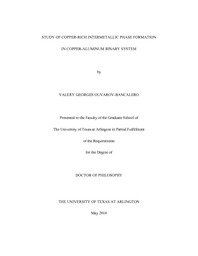
ATTENTION: The works hosted here are being migrated to a new repository that will consolidate resources, improve discoverability, and better show UTA's research impact on the global community. We will update authors as the migration progresses. Please see MavMatrix for more information.
Show simple item record
| dc.contributor.advisor | Meletis, Efstathios | |
| dc.creator | Ouvarov-Bancalero, Valery Georges | |
| dc.date.accessioned | 2018-06-05T17:58:11Z | |
| dc.date.available | 2018-06-05T17:58:11Z | |
| dc.date.created | 2018-05 | |
| dc.date.issued | 2018-05-04 | |
| dc.date.submitted | May 2018 | |
| dc.identifier.uri | | |
| dc.identifier.uri | http://hdl.handle.net/10106/27435 | |
| dc.description.abstract | This work aims to study the initial formation and subsequent growth of intermetallic compounds (IMC) in the binary Al-Cu system. Al-Cu pair configurations have been successfully used for several decades as structural components, and extensive research on their mechanical and metallurgical properties is available. More recently, the microelectronics industry started implementing the Cu wire-bond technology, which renewed the interest of the scientific community. As with every technological evolution, initial quality and reliability issues arose. Copper (Cu) wire to aluminum (Al) bond-pad is prone to crack nucleation leading to failure at the interface between Cu and Cu-rich IMCs. Even though numerous studies are available on the subject, the wire bonding configuration makes the interface characterizations difficult and many unanswered questions remain. Consequently, and using an alternative approach, the main motivation of this study was to determine the exact causes and underlying mechanisms responsible for the failure of Cu bonds. In the first part of this work, Al-Cu diffusion couples were fabricated. A Cu plate (bulk) was sputtered with a ~2µm thick Al thin film. This thin film-bulk interdiffusion configuration mimics the one of the wire bonding, while bringing the advantage of surface accessibility and exaggerated IMC growth for more accurate characterizations. Preliminary results after thermal aging under different conditions show that it is not the commonly thought γ-Cu₉Al₄ IMC that is responsible for crack nucleation, but rather a new phase, named α’ for the sake of this work. Scanning electron microscope (SEM) micrographs clearly show that delamination occurs following the α’/Cu interface. X-ray diffraction (XRD) patterns reveal that this phase is based on a face-centered cubic (FCC) structure, very similar to Cu. With a lattice mismatch of less than 2%, it is at this point hypothesized that α’ grows epitaxially on Cu, producing a compressive-tensile stress situation; misfit dislocations start nucleating after the α’ layer reaches a critical thickness, where the interfacial strain energy becomes too high for the system to bear. More in-depth XRD analyses, such as d-spacing/lattice parameter evolution in both α’ and Cu, and Williamson-Hall analysis converge in this direction. The second part of this work is dedicated to understanding the origin of α’ formation, its exact crystal structure, as well as its relationship to the Al-Cu phase diagram. Identical diffusion couples were subjected to high temperature thermal treatment and α’ was found to coexist with other equilibrium phases, such as β-Cu₃Al and γ-Cu₉Al₄, at given temperatures on the Cu side of the diffusion couple. Further proofs of its existence were found by high-resolution transmission electron microscope (HRTEM) analyses carried out on the same diffusion couple. Careful analysis and simulations of the selected area electron diffraction (SAED) patterns unmistakably revealed faint and diffuse superlattice reflections corresponding to a D0₂₂ crystal structure. Finally, the last section of the project demonstrates the solid-state epitaxial growth of α’ on Cu. A (111) Cu single crystal was sputtered with ~1µm thick Al thin film and aged under controlled atmosphere. XRD investigations in both Bragg-Brentano, and rocking curve (RC) configurations revealed the out-of-plane epitaxial relationship between α’ and Cu. In-plane epitaxy was then determined by means of HRTEM cross-section micrographs of the interface, assisted by corresponding FFT computations. Results reported in the overall investigation brought a comprehensive and plausible way to explain failure mechanisms in Cu wire bonding technology. | |
| dc.format.mimetype | application/pdf | |
| dc.language.iso | en_US | |
| dc.subject | Intermetallic compound | |
| dc.subject | TEM | |
| dc.subject | Interdiffusion | |
| dc.title | STUDY OF COPPER-RICH INTERMETALLIC PHASE FORMATION IN COPPER-ALUMINUM BINARY SYSTEM | |
| dc.type | Thesis | |
| dc.degree.department | Materials Science and Engineering | |
| dc.degree.name | Doctor of Philosophy in Materials Science and Engineering | |
| dc.date.updated | 2018-06-05T18:00:18Z | |
| thesis.degree.department | Materials Science and Engineering | |
| thesis.degree.grantor | The University of Texas at Arlington | |
| thesis.degree.level | Doctoral | |
| thesis.degree.name | Doctor of Philosophy in Materials Science and Engineering | |
| dc.type.material | text | |
Files in this item
- Name:
- OUVAROVBANCALERO-DISSERTATION- ...
- Size:
- 10.94Mb
- Format:
- PDF
This item appears in the following Collection(s)
Show simple item record


